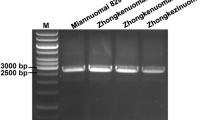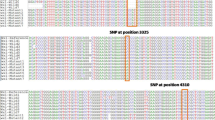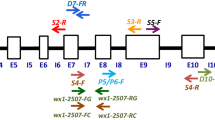Abstract
Four pairs of specific PCR primers have been designed on the basis of the sequence of the granule-bound starch synthase gene (GBSS; dominant non-waxy gene Wx) and used to amplify its homologous sequence from thirteen waxy and two non-waxy inbred lines. Results from electrophoresis indicated that the recessive waxy gene was wx, derived from the dominant non-waxy gene Wx by mutation at its 3′ end. The sequence of the mutated 3′ end was amplified by the TAIL-PCR technique. Sequence alignment showed that the mutation of the wx gene was caused by transposition of the aldehyde dehydrogenase gene rf2. Two pairs of specific primers were designed on the basis of the sequence difference between the dominant gene Wx and its mutated recessive allele wx and used as intragenic selection markers to identify individual plants of genotypes WxWx, Wxwx, and wxwx by PCR amplification from the segregating population of the F2 generation crossed between waxy and non-waxy inbred lines. Iodine solution staining and starch component assay showed that all the 35 F2 plants identified as genotype WxWx produced non-waxy kernels of the F3 generation and that all 33 F2 plants identified as genotype wxwx produced waxy kernels of the F3 generation. This result can be used to improve the selection efficiency of waxy maize breeding and for selection of other single genes and major polygenes.








Similar content being viewed by others
References
Amikam D, Niv D, Lachter J, Eidelman S et al (1997) The use of DNA markers in the pre-clinical diagnosis of familial adenomatous polyposis. Isr J Med Sci 33:63–65
Andersen JR, Lubberstedt T (2003) Functional markers in plants. Trends Plant Sci 8:554–560
Balding DJ, Bishop M, Cannings C (2003) Handbook of statistical genetics, 2nd edn. John Wiley & Sons Ltd, West Sussex
Cui X, Wise RP, Schnable PS (1996) The rf2 nuclear restorer gene of male sterile T-cytoplasm maize. Science 272:1334–1336
Don RH, Cox PT, Wainwright DJ (1991) “Touchdown” PCR to circumvent spurious priming during gene amplification. Nucleic Acid Res 19:4008
Dunne V, Maselli RA (2004) Common founder effect of rapsyn N88K studied using intragenic markers. J Hum Genet 49:366–369
Kata SR, Taylor BH, Bockholt AJ et al (1994) Identification of opaque-2 genotypes in segregating populations of quality protein maize by analysis of restriction fragment length polymorphisms. Theor Appl Genet 89:407–412
Klosgen RB, Gierl A, Schwarz-Sommer Zs et al (1986) Molecular analysis of the waxy locus of Zea mays. Mol Gen Genet 203:237–244
Knapp SJ (1998) Marker-assisted selection as a strategy for increasing the probability of selecting superior genotypes. Crop Sci 38:1164–1174
Korytina GF, Viktorova TV, Uvashchenko TE et al (2003) Analysis of intragenic polymorphic markers of the CFTR gene in cystic fibrosis patients and health donors from Bashkorostan. Genetika 39:1542–1549
Lalitha SK (1999) DNA markers in plant improvement. Biotech Adv 17:143–182
Lee M (1995) DNA markers and plant breeding programs. Adv Agron 55:265–344
Leister D, Ballvora A, Salamini F et al (1996) A PCR-based approach for isolating pathogen resistance genes from potato with potential for wide application in plants. Nat Genet 14:376–378
Liu JL (2002) Maize breeding, 2nd edn. Agriculture Press of China, Beijing
Liu YG, Mitsukawa N, Oosumi T (1995) Efficient isolation and mapping of Arabidopsis thaliana T-DNA insert junctions by thermal asymmetric interlaced PCR. Plant J 8:457–463
MuForster C (1996) Physical associated of starch biosynthetic enzymes with starch granules of maize endosperm. Granule-associated forms of starch synthase and starch branching enzyme II. Plant Physiol 111:821–829
Munroe PB, Rapola J, Mitchison HM et al (1996) Prenatal diagnosis of Batten’s disease. Lancet 347:1014–1015
National Standard Bureau of China (1985) Method of total starch content assay in cereal grains (GB5006-85). China Standard Press, Beijing
Nelson OE (1968) The waxy locus in maize. II. The location of the controlling element alleles. Genetics 60:507–524
Nelson OE, Rines HW (1962) The enzymatic deficiency in the waxy mutation of maize. Biochem Biophys Res Commun 9:297–300
Ribaut JM, Hoisington D (1998) Marker-assisted selection: new tools and strategies. Trends Plant Sci 3:236–239
Rong TZ, Li WC, Yang KC et al (2003) Maize breeding in southwest ecological region. Agricultural Press of China, Beijing
Saghai-Maroof MA, Soliman KM et al (1984) Ribosomal DNA spacer-length polymorphisms in barley: Mendelian inheritance, chromosomal location, and population dynamics. Proc Natl Acad Sci USA 81:8014–8018
Tsai PS (1974) The function of the waxy locus in starch synthesis in maize endosperms. Biochem Genet 11:83–96
Wessler SR, Baran G, Varagona M et al (1986) Excision of Ds produces waxy protein with a range of enzymatic activities. EMBOJ 5:2427–2432
Yandell DW, Dryja TP, Little JB (1990) Molecular genetic analysis fo recessive mutations at a heterozygous autosomal locus in human cells. Mutat Res 229:89–102
Acknowledgements
This work was supported by Rockefeller Foundation (2004 FS 047) and the Program for Changjiang Scholars and Innovative Research Team in University (IRT0453).
Author information
Authors and Affiliations
Corresponding author
Rights and permissions
About this article
Cite this article
Liu, J., Rong, T. & Li, W. Mutation loci and intragenic selection marker of the granule-bound starch synthase gene in waxy maize. Mol Breeding 20, 93–102 (2007). https://doi.org/10.1007/s11032-006-9074-6
Received:
Accepted:
Published:
Issue Date:
DOI: https://doi.org/10.1007/s11032-006-9074-6




